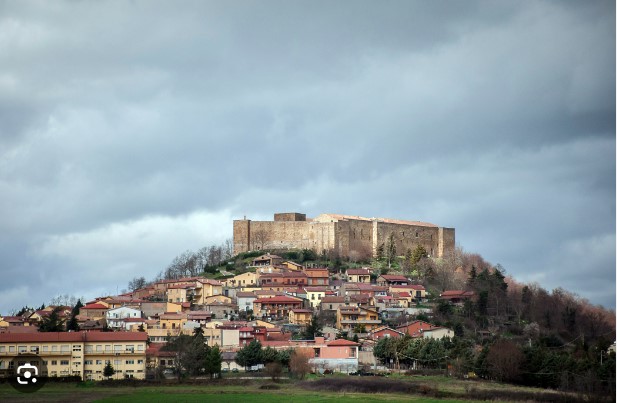Vulture, an area in northern Basilicata in southern Italy, was named after the extinct volcano at its heart. Inhabited since the dawn of time, centuries-old villages stand in the midst of a picturesque and varied rural landscape. The volcano is covered by an extensive green mantle of woods and forests, and its striking profile is visible hundreds of kilometers away, given its remarkable height of about almost 4,000 feet. It’s a niche destination from a tourist’s point of view, and you may not be familiar with it, but one that has many gems to offer us.

An ideal starting point for your visit is the ancient village of Lagopesole, dominated from above by its imposing castle. This majestic medieval manor, constructed entirely of granite, was built by the illustrious Swabian emperor Frederick II, who used it as a hunting lodge. If the elegant and regal appearance prevails in the facades, inside, in addition to the stupendous keep and spacious courtyards, it’s the palatine chapel that captivate us with its play of light and shadow, creating an atmosphere of intense spirituality.
A little less than 30 km from Lagopesole in a northwesterly direction, not far from the already mentioned volcano we find the enchanting Monticchio Lakes, ancient volcanic craters. Just a few meters apart, they are distinguished by their crystal-clear waters and the thick vegetation that surrounds them, consisting mostly of centuries-old pine and chestnut trees. It almost feels like Switzerland, and locals often go there for relaxing walks or on boat trips. In addition to its charm, there is also an interesting mystical aspect to this earthly paradise, as there are two abbeys, one a very old one whose ruins evoke an atmosphere typical of European Romanticism– namely the Abbey of St. Hippolytus–and the other, the all-white Abbey of St. Michael Archangel, located high above, dominating the two lakes, offering a privileged vantage point to fully enjoy the beauty of the place.

Leaving the Lakes and heading northeast toward Melfi, we come across the fairy-tale town of Rapolla. Renowned for its relaxing and healing thermal waters, it’s a great place to wander and maybe even get lost among its narrow streets and stone houses.
The real attraction, however, are its ancient wine tasting cellars. The local wine, Aglianico del Vulture, is made from grapes that thrive in the volcanic soil that yield an excellent red wine with a a rich fruity flavor, perfect as an accompaniment to game.
About 5 km north of Rapolla we find Melfi, a town with roots in ancient Rome and a rich and important past, especially in the Middle Ages when the Normans selected it as the capital of the vast Kingdom of Apulia and Calabria. The Castle of Melfi is a monument owned by the Italian State and one of the most important medieval castles in Southern Italy. Its construction, at least the components still visible, dates back to the Norman conquest and has undergone significant changes over time, especially under the House of Anjou and the Crown of Aragon.

Since 1976 it’s been home to the important Museo Nazionale Archeologico Melfese, housing artifacts found in the area, from prehistoric times and all the periods of settlement including the Daunian, Samnite, Lucanian and Roman periods. The most famous piece is the sarcophagus of Rapolla, a valuable example of imperial sculpture from the 2nd century CE, which came to light in 1856.
As far as gastronomic excellences are concerned, in addition to the already mentioned Aglianica wine, the area produces a PDO (“Protected Designation of Origin” ) olive oil with an intense and spicy flavor.

The cuisine of the area is simple: rustic and genuine. One of the most recognizable is pasta mollicata which has become popular all over the world. Another is Ciaudedda Lucania which combines artichokes, smoky pancetta and fava beans.












